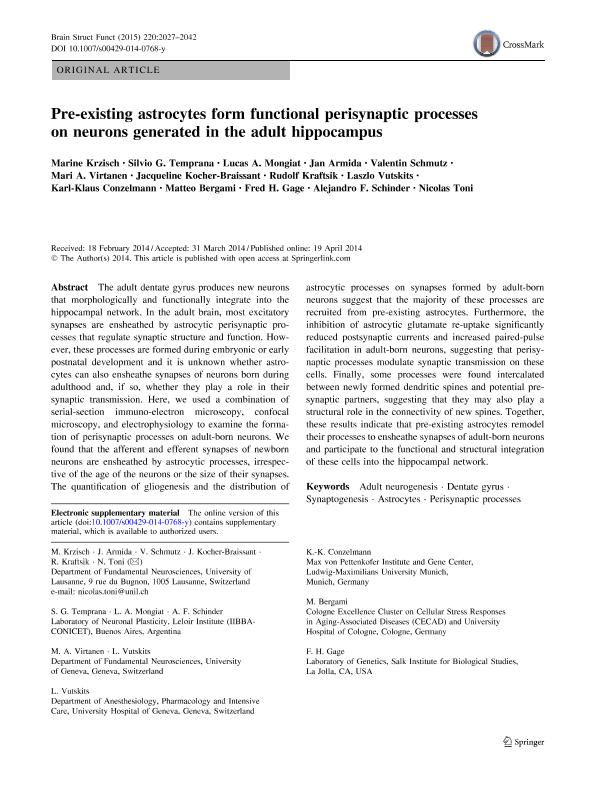Mostrar el registro sencillo del ítem
dc.contributor.author
Krzisch, Marine
dc.contributor.author
Temprana, Silvio Gabriel

dc.contributor.author
Mongiat, Lucas Alberto

dc.contributor.author
Armida, Jan
dc.contributor.author
Schmutz, Valentin
dc.contributor.author
Virtanen, Mari A.
dc.contributor.author
Kocher Braissant, Jacqueline
dc.contributor.author
Kraftsik, Rudolf
dc.contributor.author
Vutskits, Laszlo
dc.contributor.author
Conzelmann, Karl Klaus
dc.contributor.author
Bergami, Matteo
dc.contributor.author
Gage, Fred H.
dc.contributor.author
Schinder, Alejandro Fabian

dc.contributor.author
Toni, Nicolas
dc.date.available
2016-12-13T21:07:59Z
dc.date.issued
2015-07
dc.identifier.citation
Krzisch, Marine; Temprana, Silvio Gabriel; Mongiat, Lucas Alberto; Armida, Jan; Schmutz, Valentin; et al.; Pre-existing astrocytes form functional perisynaptic processes on neurons generated in the adult hippocampus; Springer Heidelberg; Brain Structure & Function; 220; 4; 7-2015; 2027-2042
dc.identifier.issn
1863-2653
dc.identifier.uri
http://hdl.handle.net/11336/9313
dc.description.abstract
The adult dentate gyrus produces new neurons that morphologically and functionally integrate into the hippocampal network. In the adult brain, most excitatory synapses are ensheathed by astrocytic perisynaptic processes that regulate synaptic structure and function. However, these processes are formed during embryonic or early postnatal development and it is unknown whether astrocytes can also ensheathe synapses of neurons born during adulthood and, if so, whether they play a role in their synaptic transmission. Here, we used a combination of serial-section immuno-electron microscopy, confocal microscopy, and electrophysiology to examine the formation of perisynaptic processes on adult-born neurons. We found that the afferent and efferent synapses of newborn neurons are ensheathed by astrocytic processes, irrespective of the age of the neurons or the size of their synapses. The quantification of gliogenesis and the distribution of astrocytic processes on synapses formed by adult-born neurons suggest that the majority of these processes are recruited from pre-existing astrocytes. Furthermore, the inhibition of astrocytic glutamate re-uptake significantly reduced postsynaptic currents and increased paired-pulse facilitation in adult-born neurons, suggesting that perisynaptic processes modulate synaptic transmission on these cells. Finally, some processes were found intercalated between newly formed dendritic spines and potential presynaptic partners, suggesting that they may also play a structural role in the connectivity of new spines. Together, these results indicate that pre-existing astrocytes remodel their processes to ensheathe synapses of adult-born neurons and participate to the functional and structural integration of these cells into the hippocampal network.
dc.format
application/pdf
dc.language.iso
eng
dc.publisher
Springer Heidelberg

dc.rights
info:eu-repo/semantics/openAccess
dc.rights.uri
https://creativecommons.org/licenses/by-nc-sa/2.5/ar/
dc.subject
Adult Neurogenesis
dc.subject
Dentate Gyrus
dc.subject
Synaptogenesis
dc.subject
Astrocytes
dc.subject
Perisynaptic Processes
dc.subject.classification
Neurociencias

dc.subject.classification
Medicina Básica

dc.subject.classification
CIENCIAS MÉDICAS Y DE LA SALUD

dc.title
Pre-existing astrocytes form functional perisynaptic processes on neurons generated in the adult hippocampus
dc.type
info:eu-repo/semantics/article
dc.type
info:ar-repo/semantics/artículo
dc.type
info:eu-repo/semantics/publishedVersion
dc.date.updated
2016-12-12T14:31:06Z
dc.journal.volume
220
dc.journal.number
4
dc.journal.pagination
2027-2042
dc.journal.pais
Alemania

dc.journal.ciudad
Berlin
dc.description.fil
Fil: Krzisch, Marine. University of Lausanne. Department of Fundamental Neurosciences; Suiza
dc.description.fil
Fil: Temprana, Silvio Gabriel. Consejo Nacional de Investigaciones Científicas y Técnicas. Oficina de Coordinación Administrativa Parque Centenario. Instituto de Investigaciones Bioquimicas de Buenos Aires; Argentina. Fundación Instituto Leloir; Argentina
dc.description.fil
Fil: Mongiat, Lucas Alberto. Consejo Nacional de Investigaciones Científicas y Técnicas. Oficina de Coordinación Administrativa Parque Centenario. Instituto de Investigaciones Bioquimicas de Buenos Aires; Argentina. Fundación Instituto Leloir; Argentina
dc.description.fil
Fil: Armida, Jan. University of Lausanne. Department of Fundamental Neurosciences; Suiza
dc.description.fil
Fil: Schmutz, Valentin. University of Lausanne. Department of Fundamental Neurosciences; Suiza
dc.description.fil
Fil: Virtanen, Mari A.. Universidad de Ginebra; Suiza
dc.description.fil
Fil: Kocher Braissant, Jacqueline. University of Lausanne. Department of Fundamental Neurosciences; Suiza
dc.description.fil
Fil: Kraftsik, Rudolf. University of Lausanne. Department of Fundamental Neurosciences; Suiza
dc.description.fil
Fil: Vutskits, Laszlo. Universidad de Ginebra; Suiza. University Hospital of Geneva. Department of Anesthesiology, Pharmacology and Intensive Care; Suiza
dc.description.fil
Fil: Conzelmann, Karl Klaus. Ludwig-Maximilians University Múnich. Max von Pettenkofer Institute and Gene Center; Alemania
dc.description.fil
Fil: Bergami, Matteo. University Hospital of Cologne; Alemania
dc.description.fil
Fil: Gage, Fred H.. Salk Institute for Biological Studies; Estados Unidos
dc.description.fil
Fil: Schinder, Alejandro Fabian. Consejo Nacional de Investigaciones Científicas y Técnicas. Oficina de Coordinación Administrativa Parque Centenario. Instituto de Investigaciones Bioquimicas de Buenos Aires; Argentina. Fundación Instituto Leloir; Argentina
dc.description.fil
Fil: Toni, Nicolas. University of Lausanne. Department of Fundamental Neurosciences; Suiza
dc.journal.title
Brain Structure & Function

dc.relation.alternativeid
info:eu-repo/semantics/altIdentifier/url/http://link.springer.com/article/10.1007%2Fs00429-014-0768-y
dc.relation.alternativeid
info:eu-repo/semantics/altIdentifier/doi/http://dx.doi.org/10.1007/s00429-014-0768-y
dc.relation.alternativeid
info:eu-repo/semantics/altIdentifier/url/https://www.ncbi.nlm.nih.gov/pmc/articles/PMC4481333/
Archivos asociados
